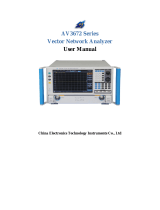
Low Consumption Power, Excellent Eco
Product
The MS2830A meets Anritsu “Excellent eco products” standard for
environment-friendly products. It cuts consumed power by 50%
compared to conventional models.
Power Consumption:
≤350 VA (including all options)
110 VA (nominal, with Opt. 040, 3.6 GHz
∗
1
)
110 VA (nominal, with Opt. 041, 6 GHz
∗
1
)
130 VA (nominal, with Opt. 043, 13.5 GHz
∗
1
)
∗1: One of the Opt. 040, 041 or 043. Excludes other options.
Resolution Bandwidth (RBW)
Setting Range
Spectrum Analyzer:
1 Hz to 3 MHz (1-3 sequence),
50 kHz, 5 MHz, 10 MHz, 20 MHz
∗
2
, 31.25 MHz
∗
2, 3
,
200 Hz (6 dB)
∗
4
, 9 kHz (6 dB)
∗
4
, 120 kHz (6 dB)
∗
4
,
1 MHz (Impulse)
∗
4
Spectrum trace in signal analyzer mode:
1 Hz to 1 MHz (1-3 sequence)
∗
5
1 Hz to 3 MHz (1-3 sequence)
∗
6
1 Hz to 10 MHz (1-3 sequence)
∗
7
When monitoring two adjacent signals, the frequency resolution
can be increased by reducing the resolution bandwidth (RBW).
This also has the effect of reducing the noise level.
Conversely, to confirm level variations of 20-MHz band signals
such as LTE and WiMAX, set the RBW to 31.25 MHz.
∗2: Can be set when with Opt. 005.
∗3: Instead of Gaussian filter, 31.25 MHz RBW uses filter with flat top
characteristics above 31.25 MHz.
∗4: When Opt. 016 installed.
∗5: Without Opt. 077/078, or Bandwidth: ≤31.25 MHz.
∗6: With Opt. 077, Bandwidth: >31.25 MHz.
∗7: With Opt. 078, Bandwidth: >31.25 MHz.
Gate Sweep
Gate sweep executes sweeping only for the length of time specified
by the gate length, starting from when the trigger condition is met.
A delay time until sweeping starts after the trigger condition is met
can be set using trigger delay.
• The gate source can be selected from the following
- Wide IF video trigger
- External trigger
- Frame trigger
- SG marker trigger (Requires Opt. 020/021)
• Setting range and resolution for gate delay
- Setting range: 0 to 1 s
- Resolution: 20 ns
• Setting range and resolution for gate length
- Setting range: 50 us to 1 s
- Resolution: 20 ns
Trigger Function
Trigger sweep executes sweeping using the specified trigger
condition as the start point. In particular, “SG Marker” starts
analyzer measurement in synchrony with the signal output by
installing Opt. 020/021. Using this function supports simple
synchronized measurement even when evaluating signals with
large level variation over time, such as modulation signals.
• Video trigger:
Trigger sweeping starts in synchronization with the rise or fall
of the waveform. A trigger level indicator showing the trigger
level is displayed on the screen.
• Wide IF video trigger:
An IF signal with a wide passing band of about 5 MHz is
detected, and sweeping starts in synchronization with either
the rise or fall of the detected signal.
• External trigger:
Sweeping starts in synchronization with the rise or fall of the
signal input via the Trigger Input connector.
• Frame trigger:
An equipment-internal trigger signal is used to generate a
trigger and start the sweep. The generation period (Period)
and offset time (Offset) for the trigger signal can be set. It is
also possible to re-synchronize the trigger signal with either
the Wide IF Video signal or an external trigger.
• SG Marker trigger (Requires Opt. 020/021):
Sweeping starts in synchronization with the rise or fall of the
marker signal output of Opt. 020/021. This function supports
measurement in synchronization with the output signal of
Opt. 020/021.
Three Built-in External Interfaces
The built-in Gigabit Ethernet, USB2.0, and GPIB interfaces support
remote operation.
GPIB: IEEE488.2, Rear panel, IEEE488 bus connector
Interface functions: SH1, AH1, T6, L4, SR1, RL1, PP0,
DC1, DT0, C0, E2
Ethernet: 10/100/1000BASE-T, Rear panel, RJ-45
USB (B): USB2.0, Rear panel, USB-B connector
Saving Measurement Results
Measurement results can be saved to internal hard disk or external
USB memory. Screen dumps and trace data can be saved too.
• Screen dump file type
- BMP
- PNG
• The color of the screen hard copy can be set as follows:
- Normal (same as screen display)
- Reverse
- Monochrome
- Reversed Monochrome
Basic Performance
10 Product Brochure
l
MS2830A






















